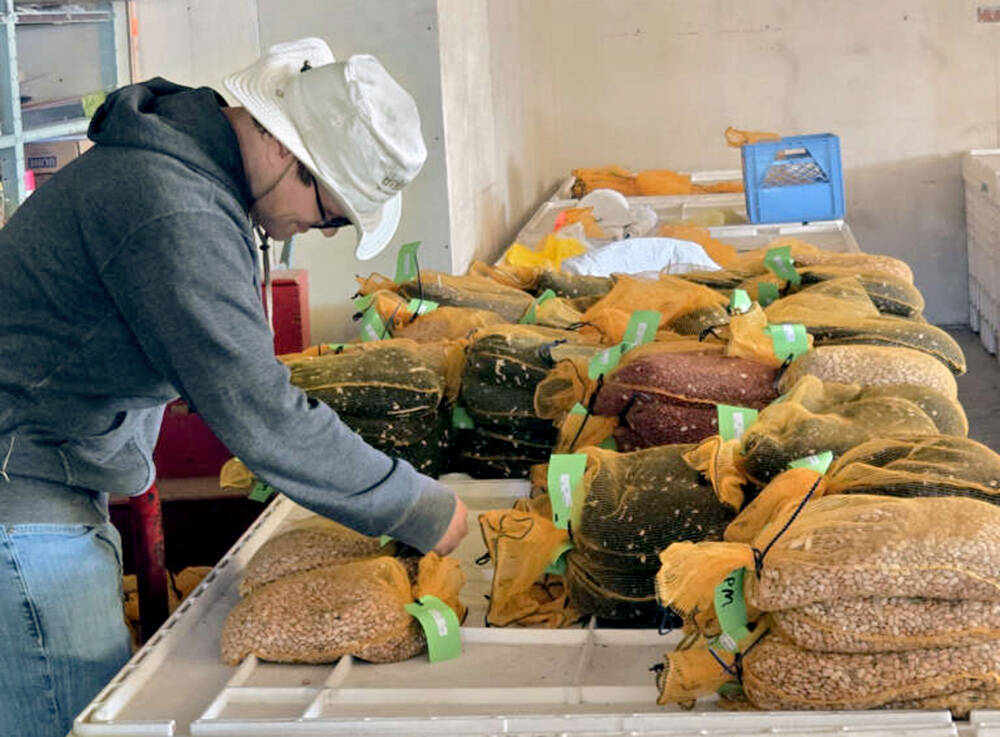Ontario farmers have sold the bulk of their corn, soybeans and wheat, so basis levels are expected to strengthen later in winter as commercial stocks decline. Statistics Canada will release its survey results of Dec. 31, 2022 farm stocks on Feb. 7.
Ontario soybean prices are at the highest levels since August. Soybean export demand has been exceeding year-ago levels so the domestic market will have to ration demand by trading above world values later in spring.
Quick look
Soybeans: Planting and weather conditions during the growing season will determine market sensitivity.
Corn: The basis will likely tighten after March 31 as seasonal demand for domestic feed and exports increases.
Wheat: It’s likely that exports from the Black Sea will come to a halt in April.
Read Also

Bean research breeds community giving
University of Guelph dry bean researcher Dr. Mohsen Yoosefzadeh Najafabadi champions sustainability by donating surplus breeding program beans to support food security and community art initiatives.
Corn prices are relatively unchanged from our last issue. The domestic market will determine the price structure from January through March. From March through June, export demand will significantly increase, resulting in stronger elevator bids.
The wheat market is sleeping because export demand is quiet. Canadian and U.S. flour millers are covered through March. We’re forecasting a major rally in the Ontario wheat market during April. Ontario on-farm wheat stocks are rather snug and could drop to historical lows on July 31.
The Brazilian soybean crop is developing under favourable conditions. Record production is expected. The crop is developing on time with harvest beginning in the west central region. Supplies will be available for export in early February. Brazil’s main second corn crop will be planted in February.
Soybean planting in Argentina was approximately 80 per cent complete as of Jan. 8 and the crop was only rated 10 per cent good to excellent. Approximately 80 per cent of the Argentine corn was planted and the crop was rated only 15 per cent good to excellent. The Australian wheat harvest is in the final stages. Wheat exports from Russia and Ukraine are uncertain beyond March 19. The U.S. Southern Plains continue to experience drought-like conditions.
Canadian employers added 104,000 jobs in December. From October through December, Canada has gained 263,000 jobs. The economy is performing stronger than expected despite the elevated inflation and higher interest rates.
The Bank of Canada is expected to hike interest rates by 25 or 50 basis points at its Jan. 25 meeting. This should cause Canadian dollar appreciation against the U.S. greenback. Crude oil prices are near 52-week lows. The energy crisis is over. Ethanol and biodiesel prices are under pressure, which is a negative influence on corn and soybeans markets.
Soybeans
Soybean supplies on Ontario farms at the beginning of the 2022-23 crop year totalled 4.017 million tonnes compared to the previous year’s stocks of 4.089 million tonnes. Export demand is running slightly ahead of last year, while the domestic crush is similar to year-ago levels. Ontario on-farm soybean stocks as of Dec. 31, 2022 are expected to come in at 1.010 million tonnes, down from the previous years’ stocks of 1.140 million tonnes.
Farmers delivered approximately three million tonnes in the first four months of the crop year. At the time of writing this article, domestic crusher bids were equivalent to export offers. In the first four months of the crop year, the market functions to encourage demand due to large farmer selling. In the latter half of the crop year, the domestic market needs to ration demand by trading at a premium to world values. Commercial supplies will decline, causing basis appreciation.
During the first week of January, Brazilian export offers were US$585/tonne f.o.b. Paranagua while U.S. No. 2 soybeans were valued at $594/tonne f.o.b. the Gulf. Argentine offers for nearby positions were more than $600/tonne. Over the past month, Brazil has removed the U.S. as the most competitive supplier to the world market. Ontario soybeans were quoted at US$595/tonne f.o.b. St. Lawrence port.
Brazilian production is estimated at 152 million tonnes, up from last year’s output of 127 million tonnes. Argentine output is uncertain but trade estimates are around 40 million tonnes, which is down from 43.9 million tonnes last year. It’s still early and we could see the later planted soybeans develop under more favourable conditions.
U.S. exports will slow. The U.S. carryout for 2022-23 is expected to finish near six million tonnes, down from the 2021-22 ending stocks of 7.6 million tonnes and down from the five-year average of 13.1 million tonnes. The market will be sensitive to planting conditions and weather during the growing season. This will result in a seasonal rally during spring.
What to do: We’ve advised producers to be 80 per cent sold on their 2022 production. We plan to sell the remaining 20 per cent in April or May. The world will absorb Brazilian harvest pressure during February and March. Political unrest in Brazil may also contribute to Brazil’s ability to export significant volume.
Corn
Ontario on-farm stocks as of Dec. 31, 2022 are expected to come in at five million tonnes, while commercial stocks are forecasted at 3.1 million tonnes. This compares to year-ago levels of 4.3 million tonnes on-farm and commercial stocks of 3.8 million tonnes.
Farmers tend to sell 1.5 million tonnes between Jan. 1 and March 31, which would bring on-farm stocks to 3.5 million tonnes on March 31. Ontario corn basis tends to tighten after March 31 because this is when the market needs to pull supplies from the farmer.
Ontario ethanol margins are under pressure and the domestic market is being driven by local feed values. Ontario exports from Jan. 1 through March 31 are only forecasted to be 130,000 tonnes. During April through June, commercial supplies decline, while domestic feed and export demand are at seasonal highs. Ontario corn exports to Europe are expected to surge in May.
Brazilian corn is offered at US$298/tonne f.o.b. Paranagua, up $10/tonne from last month. U.S. corn is quoted at $306/tonne f.o.b. the Gulf. French corn was quoted at $307/tonne, up $30/tonne from last December. Ontario corn is once again more competitive than French origin into Northern European ports.
Total Brazilian corn output is expected to reach 126 million tonnes. The main second crop, which is projected to reach 100 million tonnes, will only be planted in February and harvested in June. Argentine corn production has been trimmed to 40 million tonnes, down from the previous estimate of 49.5 million tonnes.
In the U.S., the corn market needs to encourage acreage. Farmers need to increase corn acreage at the expense of soybeans. Otherwise the fundamentals for 2023-24 become extremely tight. The market cannot afford a crop problem in the U.S. We’re expecting a major rally in the corn market come April. This could be enhanced if adverse conditions develop in Brazil during pollination of the second crop.
What to do: We have advised producers to be 50 per cent sold on their 2022 corn production. Be patient to make additional sales.
Wheat
Ontario on-farm wheat stocks at the start of the 2022-23 crop year were an estimated 2.257 million tonnes. We estimate that farmers delivered 1.907 million tonnes during the first five months of the crop year. Ontario on-farm stocks as of Dec. 31 are expected to come in at 350,000 tonnes. Commercials have sufficient stocks to satisfy domestic and export demand through March.
The market will need to pull some volume from the farmer during April and May. We expect Ontario farm stocks drop to historical lows at on July 31. The main point is that the surge in farmer selling is over. The wheat market is making seasonal lows.
The world market is also making seasonal lows. We’re looking for a major rally in the wheat market come spring. The Black Sea Grain Initiative is on unstable ground. Certain insurance companies are not covering vessels out of Ukraine and Russia, causing freight rates to strengthen from this region.
The current Black Sea export agreement is expected to expire in late March. Russia appears to be preparing for a major spring offensive. There is a high probability that wheat exports come to a halt from the Black Sea in April. Ukraine and Russian wheat production for 2023 is uncertain.
The U.S. Southern Plains continue to experience drought-like conditions. Production is uncertain for 2023, which is a serious problem. U.S. soft red winter wheat has received adequate moisture and will be in good condition come March.
The European exportable surplus has been drained and French and German export prices will strengthen later in spring. There is potential for Ontario wheat to trade into North Africa in May and June as occurred in the spring of 2008.
Canadian and U.S. hard red spring wheat stocks will drop to historical lows at the end of the 2022-23 crop year. The market needs to encourage wheat acreage this spring, especially with the U.S. Southern Plains in drought. More importantly, the wheat market cannot afford adverse weather in Western Canada or North Dakota. The wheat complex will be extremely sensitive to Western Canadian weather.
What to do: We have advised producers to be 40 per cent sold on the 2022 wheat production. The conditions are ripe for a major rally in the wheat complex during April and May. At the time of writing this article, the speculative funds were short more than 32,000 contracts in Chicago wheat. There is potential for massive fund short covering and these traders could build a long to 40,000 contracts.













